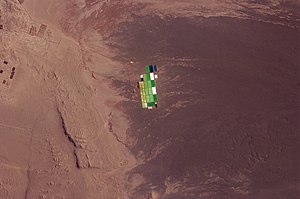Solar pond
This article needs additional citations for verification. (November 2012) |

A solar pond is a pool of saltwater which collects and stores solar thermal energy. The saltwater naturally forms a vertical salinity gradient also known as a "halocline", in which low-salinity water floats on top of high-salinity water. The layers of salt solutions increase in concentration (and therefore density) with depth. Below a certain depth, the solution has a uniformly high salt concentration.
Description
When the sun's rays contact the bottom of a shallow pool, they heat the water adjacent to the bottom. When water at the bottom of the pool is heated, it becomes less dense than the cooler water above it, and
Advantages and disadvantages
- The approach is particularly attractive for rural areas in developing countries. Very large area collectors can be set up for just the cost of the clay or plastic pond liner.
- The accumulating salt crystals have to be removed and can be a valuable by-product and a maintenance expense.
- No need for a separate collector.
- The extremely-large thermal mass means power is generated night and day.
- Relatively low-temperature operation means solar energy conversion is typically less than 2%.[2]
- Due to evaporation, non-saline water is constantly required to maintain salinity gradients.
Efficiency
The energy obtained is in the form of low-grade heat of 70 to 80 °C compared to an assumed 20 °C ambient temperature. According to the
Development
Further research is aimed at addressing the problems, such as the development of membrane ponds. These use a thin permeable membrane to separate the layers without allowing salt to pass through.
Examples
The largest operating solar pond for electricity generation was the Beit HaArava pond built in Israel and operated up until 1988. It had an area of 210,000 m² and gave an electrical output of 5 MW.[3]
India was the first Asian country to have established a solar pond in
The 0.8-acre (3,200 m2) solar pond powering 20% of Bruce Foods Corporation's operations in El Paso, Texas is the second largest in the U.S. It is also the first ever salt-gradient solar pond in the U.S.[5]
See also
- Ocean thermal energy conversion
- Ice pond
- Seasonal thermal energy storage (STES)
- Thermal storage
- Deep lake water cooling
- Cooling pond
- Salt evaporation pond
References
- ^ G. Boyle. Renewable Energy: Power for a Sustainable Future, 2nd ed.
- ^ G. Boyle. Renewable Energy: Power for a Sustainable Future, 2nd ed. Oxford, UK: Oxford University Press, 2004.
- ^ C, Nielsen; A, Akbarzadeh; J, Andrews; HRL, Becerra; P, Golding (2005), The History of Solar Pond Science and Technology, Proceedings of the 2005 Solar World Conference, Orlando, FL
{{citation}}: CS1 maint: location missing publisher (link) - ^ Solar Gradient Solar Ponds, Teriin, archived from the original on 26 October 2008, retrieved 28 November 2009.
- CiteSeerX 10.1.1.680.7971.
External links
- The El Paso Solar Pond, University of Texas, archived from the original on 2013-06-04, retrieved 2013-09-25.
- Bhuj Solar Pond in India, Teriin, archived from the original on April 2, 2007
{{citation}}: CS1 maint: unfit URL (link). - "Israel's 150 KW Solar Pond", Mother Earth news, May–Jun 1980.
- Research ponds and real world project at Pyramid Salt, Pyramid Hill, Northern Victoria, AU: Royal Melbourne Institute of Technology, archived from the original on 2012-02-05.

